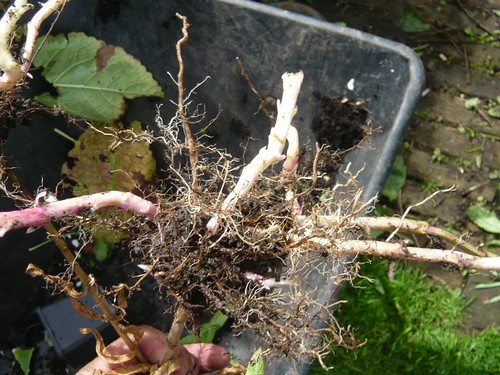Herbaceous Propagation
Divide and rule is the motto for those who wish to be king of the herbaceous garden. More plants for some little effort.
Offsets and Crowns
One of my favourite jobs is growing more primroses, primulas and polyanthus. Probably more than my garden wants or needs but as I have said before I am a quantity man not necessarily a quality gardener.
After flowering, primulas produce baby plants as a means of propagating the species in addition to seeding. Virtually each of the flowers on this primula denticula has its own new plantlet.
On a damp day I dig up clumps of Primula and tease away the roots from each new crown. Sometimes the original plant has become old and frail but more often than not it can go back into the ground refreshed and renewed to grow again for next year.

Runners and Stolon
Strawberry plants produce growths that resemble floppy stalks with leaves growing at regular intervals. These stalks lay on the ground and the leaves are tempted into rooting – several on each length. Pot these rooted runners or encourage permanent residence in the strawberry bed by planting the roots and severing them from the main plant at the same time. The best plants will be on the part of the runner nearest the host plant and you only want to take 3/4 plantlets from each host.
To protect a young strawberry plant in the first couple of season cut off the runners as soon as they appear to allow strength to be built up.
Mint and Bergenia are among other plants that can be propagated by stolon which are similar to strawberry runners.
Clump Division
Many herbaceous plants form progressively larger clumps of root.
Older Hostas can have a solid root and crown mass that can best be divided by chopping into parts with a spade.
The slice with a spade method is how I deal with Day Lilies. The only thing to worry about is ensuring several buds or eyes are left on eack resultant cutting (or should it be clumping).
Ornamental grasses and bamboos lend themselves to root division in early spring. For Pampas grass you may need a spade or even a saw but most can be pulled apart.
More Herbaceous Propagation
Adventurous roots are those that wander off above or below soil level. They can often be used to grow new plants.
Several plants such as delphiniums and oriental poppies can be propagated from pieces of root as root cuttings.
Simple stem cuttings can be potted up in September when cutting back your plants. Often this will result in lots more plants.
Offsets are similar to runners and are often found on Sempervivum house leeks.

Houseplant Propagation
Leaf cuttings are a popular way of propagating African violets and Streptocarpus
Offsets are able to root and make new plants from Aloe and Agave
Photo credits
P1030686 by jessicareeder CC BY 2.0

